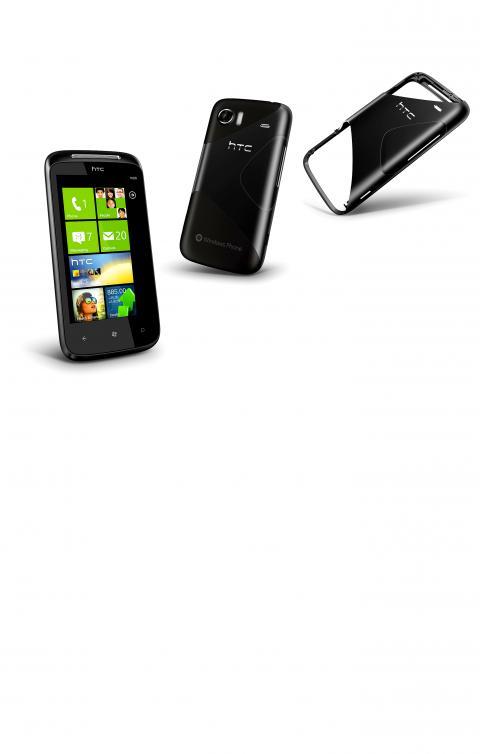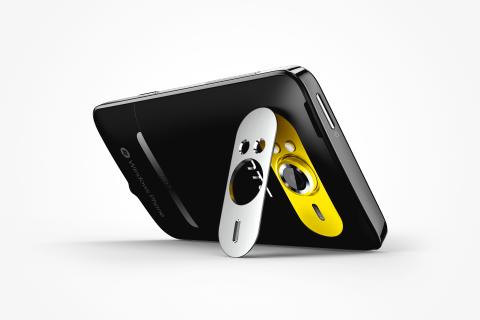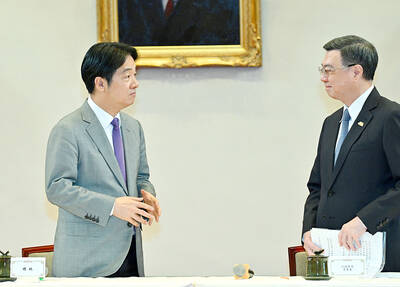The smartphone race continues. Microsoft’s new operating system, Windows Phone 7, which launched in Taiwan in December, is now available on two high-end models from Taiwan’s own HTC (宏達電), the HTC HD7 and HTC 7 Mozart.
The main reason to consider a smartphone powered by the Windows Phone 7 OS is its touch-screen interface, which matches the user friendliness of any iPhone or Android device. While it still has to play catch-up, especially with the relatively small number of apps and lack of Chinese-language capabilities, Windows Phone 7 is shaping up to be a worthy contender. (See the Taipei Times on Feb. 20 for an in-depth review of the OS.)
Choosing between the two HTC models boils down to the details. Both are similarly priced: Without a phone plan, the HTC HD7 retails for NT$20,900, while the HTC 7 Mozart is NT$18,900.

Photo courtesy of HTC
The HTC HD7’s 4.3-inch screen makes it look like a mobile phone on steroids. If you spend a lot of time watching videos or playing graphics-intensive games, this could be your device. The HD7 even has a kickstand that swivels out so you can prop it up on a table.
That generous amount of on-screen real estate also makes a noticeable difference when reading text, whether it’s in the Web browser, e-mail or the mobile version of Microsoft Office. I found typing a bit easier using the HD7’s touch-screen keyboard — the extra bit of space makes a difference.
Bigger isn’t necessarily better, though. The HTC 7 Mozart shares the same resolution (800 x 400) as the HD7, but it has a higher pixel density because of its smaller 3.7-inch screen. On the Mozart, everything looks sharper and crisper, and the quality comes pretty close to the iPhone 4’s highly praised screen.

Photo courtesy of HTC
HTC probably had the iPhone 4 in mind when designing the Mozart — it’s a similar size and sports a stylish, slim shape. But those handsome looks come at the expense of ergonomics. The aluminum casing feels a little slippery and doesn’t allow for a confident grip.
I kept worrying that I would drop the handset that HTC loaned to the Taipei Times, and indeed, I had a few close calls. Another small quibble is the placement of the volume rocker on the left side of the device: it’s too low, which makes it hard to adjust while talking on the phone.
For taking photos and video, the Mozart has the edge on the HD7. It has an 8 megapixel camera compared to the HD7’s 5 megapixel lens, and good quality snapshots are possible if you have good light. The same holds for video. I had decent results with using the Mozart to film some outdoor scenes in the daytime, but don’t bother using the device in extreme environments such as loud, dark places. A short video I shot at the Santana concert in Taipei several weeks ago turned out to be blurry, with the sound severely distorted.
One other difference between the two models is storage. The Mozart comes with 8 gigabytes, the HD7, 16 gigabytes, and unfortunately neither model can be expanded using SD cards. In terms of speed, however, the HD7 and Mozart are evenly matched, as both come equipped with 1 GHz processors and 576 MB of RAM.
Battery life is also comparable; I managed a full day without charging on both models, making a handful of calls, sending text messages, surfing the Internet and checking my Facebook and Twitter accounts throughout the day. That is not quite as good as the iPhone (I usually get at least a day and a half doing the same things), but unlike Apple’s handset, you can easily replace the battery on both HTC models.
If you plan to spend a lot of time using your smartphone, the HD7 makes for a pleasant experience because of its larger screen. But the Mozart wins on portability — it fits easier into a front jeans pocket — and the camera is noticeably better.
Both models will likely impress those who have yet to switch to a smartphone. But users of Android and Apple phones are likely to find Windows Phone 7 lacking in a few features, such as multitasking (the ability to switch between apps quickly).
Microsoft has just released an update that adds cut-and-paste functionality for text, a highly requested feature. But there’s still no multitasking, and more importantly for users in Taiwan, there’s no Chinese-language support — for now, you have to get by with third-party apps to compose e-mails or text messages in Chinese. Microsoft says an update for a Chinese version of Windows Phone 7 is due later this year.

Under pressure, President William Lai (賴清德) has enacted his first cabinet reshuffle. Whether it will be enough to staunch the bleeding remains to be seen. Cabinet members in the Executive Yuan almost always end up as sacrificial lambs, especially those appointed early in a president’s term. When presidents are under pressure, the cabinet is reshuffled. This is not unique to any party or president; this is the custom. This is the case in many democracies, especially parliamentary ones. In Taiwan, constitutionally the president presides over the heads of the five branches of government, each of which is confusingly translated as “president”

Sept. 1 to Sept. 7 In 1899, Kozaburo Hirai became the first documented Japanese to wed a Taiwanese under colonial rule. The soldier was partly motivated by the government’s policy of assimilating the Taiwanese population through intermarriage. While his friends and family disapproved and even mocked him, the marriage endured. By 1930, when his story appeared in Tales of Virtuous Deeds in Taiwan, Hirai had settled in his wife’s rural Changhua hometown, farming the land and integrating into local society. Similarly, Aiko Fujii, who married into the prominent Wufeng Lin Family (霧峰林家) in 1927, quickly learned Hoklo (commonly known as Taiwanese) and

The low voter turnout for the referendum on Aug. 23 shows that many Taiwanese are apathetic about nuclear energy, but there are long-term energy stakes involved that the public needs to grasp Taiwan faces an energy trilemma: soaring AI-driven demand, pressure to cut carbon and reliance on fragile fuel imports. But the nuclear referendum on Aug. 23 showed how little this registered with voters, many of whom neither see the long game nor grasp the stakes. Volunteer referendum worker Vivian Chen (陳薇安) put it bluntly: “I’ve seen many people asking what they’re voting for when they arrive to vote. They cast their vote without even doing any research.” Imagine Taiwanese voters invited to a poker table. The bet looked simple — yes or no — yet most never showed. More than two-thirds of those

In the run-up to the referendum on re-opening Pingtung County’s Ma-anshan Nuclear Power Plant last month, the media inundated us with explainers. A favorite factoid of the international media, endlessly recycled, was that Taiwan has no energy reserves for a blockade, thus necessitating re-opening the nuclear plants. As presented by the Chinese-language CommonWealth Magazine, it runs: “According to the US Department of Commerce International Trade Administration, 97.73 percent of Taiwan’s energy is imported, and estimates are that Taiwan has only 11 days of reserves available in the event of a blockade.” This factoid is not an outright lie — that